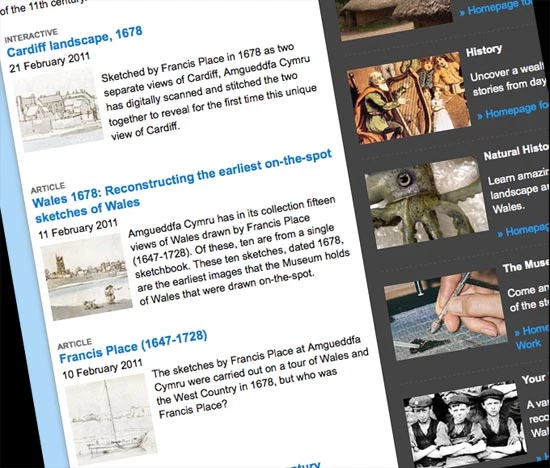Revealing historic sketches online
, 7 Mawrth 2011
Revealing the historic sketches of Francis Place for the very first time…
After Museum conservators in the Art department had completed their conservation work on the Francis Place sketchbooks – containing some of the earliest on-the-spot- sketches of Wales in the Museums collections – I was given the task of figuring out the best way in which to present these sketches online.
Secret sketches hidden for 200 years
Places' sketchbooks had been taken apart 200 years ago and their pages stuck on a woven paper backing. Recent conservation work has since revealed further sketches on the reverse – sketches that have been hidden for over 200 years.
What's more, these hidden sketches were a continuation of the panoramic view from the previous page – so by digitally stitching two double page panoramas together, new complete views could been created that would never have been possible to see before – even by the artist himself!
Now, how could we display these new super long panoramas online whilst still allowing the detail to be seen?
The default width for our webpages is set at just under 1000 pixels across, this was just not enough to be able to show off these panoramas in any detail, so I decided that the easiest solution was to add scroll bars direct to the image, allowing them to be displayed across the page whilst at the same time allowing the complete panoramas to be studied in detail.
Cardiff 1678:
One of these newly generated images is of a panoramic view of Cardiff, containing an unique view of the medieval town as it was back in 1678.
To show this detailed sketch off in the best possible way, I decided to repurpose our interactive image navigator tool, which allows the user to pan around a high resolution image viewing details close up.
By using texts from a previously published article on medieval Cardiff, I was also able to pinpoint and highlight certain aspects of the panorama that were noteworthy – be it places that have remained unchanged since medieval times, or places that have long since vanished.
Francis Place goes global
To promote this work, the marketing team at the Museum distributed several Tweets and Facebook mentions. As well as being picked up by the BBC Wales news website and local media, we also published images onto the photo sharing website Flickr and added the extra information as notes embedded within the image. To make it a bit more user focused, I posted a comment asking users to guess where the artist was postitioned as he sketched… The foreground area of the sketch has altered so dramatically since 1678, it's not as easy as it seems….



